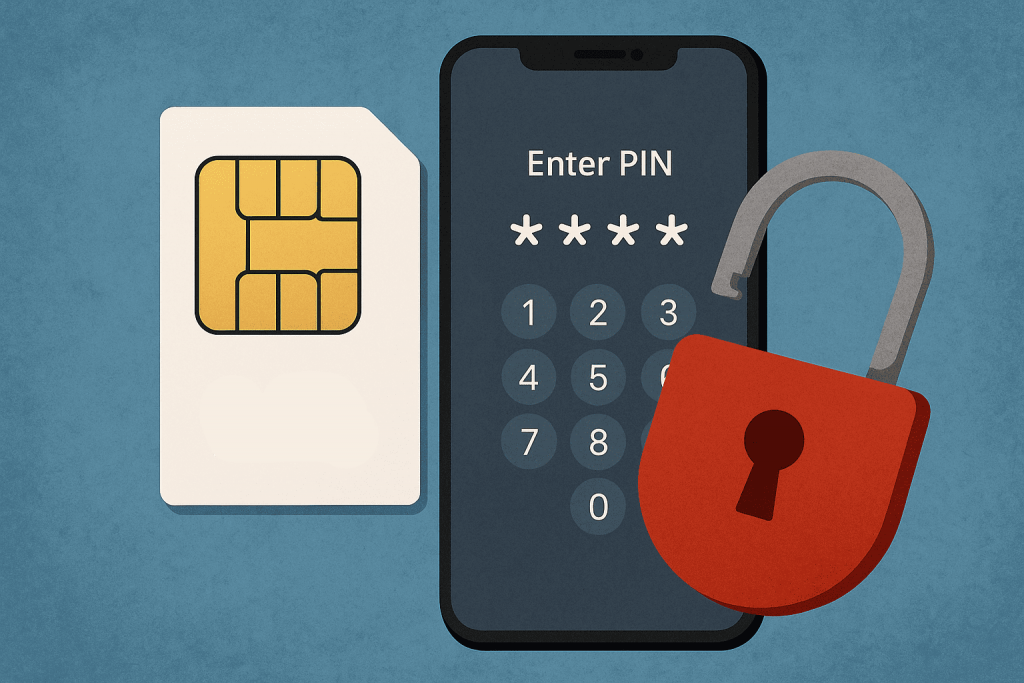
Today, a smartphone is more than just a means of communication — it’s the key to your entire digital life: online banking, social networks, email, and two-factor authentication. Many users believe that setting a PIN on their SIM card is enough to stay safe from attackers. In reality, this code is a relic of the past, designed for completely different purposes, and it cannot withstand modern cyber threats. Let’s explore why a standard SIM PIN won’t save your number — and what you can actually do to protect it.
How the PIN Was Designed to Work
A PIN (Personal Identification Number) is a four-digit code that prevents unauthorized use of your SIM card. You must enter it every time the phone is turned on or when the SIM is inserted into another device. After three incorrect attempts, the SIM is locked and requires a PUK — an eight-digit backup code — to unlock it.
When this system was created in the 1990s, its goal was simple: prevent someone from accidentally using your SIM in their phone. Back then, mobile phones were used only for calls, so it worked fine. But today, when your phone number is tied to banking apps, online accounts, and identity verification, the PIN mechanism is far too basic.
The PIN Won’t Help If the Attacker Doesn’t Have Your SIM
Modern attacks don’t usually involve stealing your phone — they exploit mobile operators. The most common scheme is SIM swapping. A fraudster calls your operator, pretends to be you, and asks to reissue the SIM card, claiming the old one was lost or damaged. To confirm identity, they provide easily obtained personal details — name, date of birth, last top-up amount, or answers to security questions. Within minutes, your number is active on another device. The PIN doesn’t matter here because the operator issues a brand-new SIM with your number.
Once activated, the attacker gains access to your bank SMS messages, password recovery codes, and even social media or messaging accounts through “Forgot password?” links — all without touching your phone, simply by exploiting weak verification procedures and human error.
SIM Cloning: The Hidden Danger
Another threat is SIM cloning. If an attacker gets brief physical access to your SIM card, they can copy its unique IMSI and Ki encryption keys, creating a duplicate. This “clone” works in parallel with the original and can intercept calls and SMS. It’s a more complex operation but possible, especially for corporate users or public figures. Again, the PIN doesn’t help — it only blocks the original card from activation, not its clones.
Human Error: The Weakest Link
Most users keep the default PIN provided with the SIM — often 0000 or 1234. Such codes are easy to guess. Some disable PIN protection entirely to avoid typing it in. Others use personal data — birth dates, years, or house numbers — as codes. All of this makes guessing or social engineering attacks trivial.
The problem is psychological: the PIN gives a false sense of security. It doesn’t protect your number itself, and once an attacker bypasses the operator’s verification or tricks customer service, they gain full control over your digital identity.
The Risks of Losing Control of Your Number
Modern apps and services rely heavily on your phone number — SMS are used to confirm logins to Telegram, Facebook, Google, and banking apps. Losing access to your SIM means losing access to all of these platforms. Attackers can change passwords, delete backups, transfer money, or lock you out of your own accounts. In the worst case, they might impersonate you to commit fraud.
Even worse, such attacks often go unnoticed. You might only realize something’s wrong when your phone suddenly loses service and the operator says “your number is already active on another SIM.” By then, it’s too late — your SMS codes are already in someone else’s hands.
How to Actually Stay Safe
First, change the default PIN to a unique one not related to your personal information.
Second, enable protection against remote SIM replacement — many operators now require in-person verification or video ID before issuing a new card.
Third, use app-based two-factor authentication (like Google Authenticator, Authy) or hardware keys (like YubiKey) instead of SMS. These methods are independent of your phone number, so even if the SIM is swapped, your accounts remain safe.
If you have a corporate or public-facing number, consider separating personal and business lines. The fewer people know your real number, the safer it is from being exploited.
Security Is More Than Just Your Phone
A SIM card is just one link in the chain. If your website transmits data without HTTPS, no PIN will protect you. Security must be holistic: encrypted connections, reliable authentication, backups, and strict access control to critical systems.
The true weakness of the PIN lies not in its simplicity but in the illusion that “everything is under control.” Today’s hackers use social engineering, data leaks, and carrier vulnerabilities. The sooner we move beyond outdated tools, the safer we’ll be.
Real Protection Means Awareness
A SIM PIN is a relic of the past. It can serve as an additional layer of protection, but relying on it alone is dangerous. Think broader — review your account security settings, use unique passwords, enable multifactor authentication, and avoid sharing your phone number unnecessarily.
Security isn’t a one-time action — it’s an ongoing process. Even the smallest details can become entry points for attackers — from a SIM card to your business website. That’s why at RX-NAME you can order SSL certificates that ensure a secure connection between your website and users. If a PIN is the minimum protection for your phone, SSL is a shield for your website. In both cases, never underestimate security — it’s what determines who truly controls your data: you or someone else.

Leave a Reply